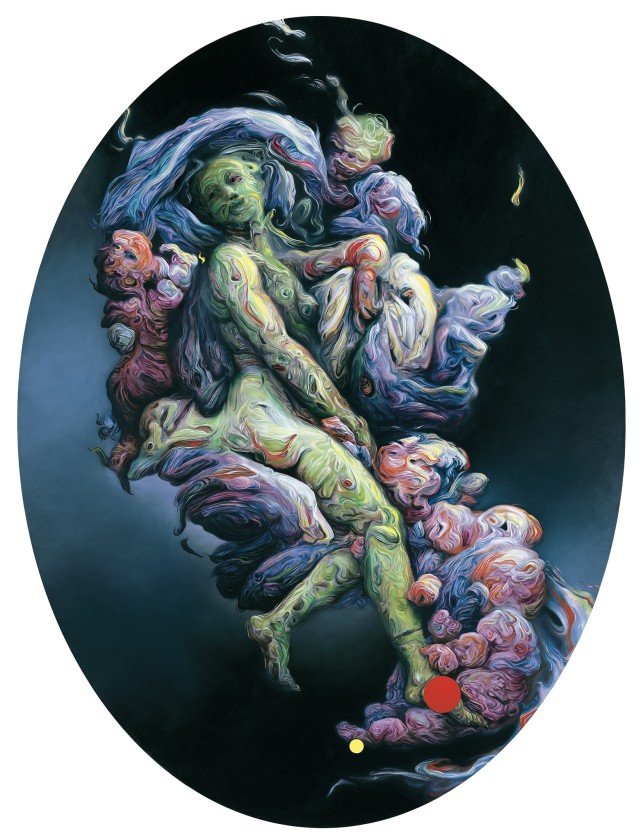Painting is Painting's Favorite Food: Art History as Muse: South Etna Montauk, Montauk, New York
Derrick Adams, Glenn Brown, Scott Covert, John Currin, Jesse Edwards, Hadi Fallahpisheh, Rachel Feinstein, Luis Flores, Doreen Garner, Clarity Haynes, Lyle Ashton Harris, Andrew LaMar Hopkins, Jane Kaplowitz, Karen Kilimnik, Dennis Kardon, Chris Oh, Borna Sammak, Peter Saul, Sally Saul, Betty Tompkins, Piotr Uklański, and Lynette Yiadom-Boakye.
Curated by Alison Gingeras
Asger Jorn, the great Danish artist and mastermind of the CoBrA movement, always had a zinger up his sleeve. He famously sent a mordant telegram to Harry F. Guggenheim, refusing the Guggenheim Prize with a single sentence: “Go to hell with your money, Bastard!” Jorn titled one of his most famous modifications—his term for painting on top of anonymous thrift store canvases—The Avant Garde Won’t Give Up. And in speaking about the voracious cultural consumption required of the creative act, he declared, “Painting is painting’s favorite food,” encapsulating the vital role that art history plays in most artists’ practice.
Jorn’s quip serves as both inspiration and exposition for Painting is Painting’s Favorite Food: Art History as Muse, the debut presentation at South Etna Montauk, opening July 16, 2020 in the Village of Montauk on the East End of Long Island. Curated by Alison M. Gingeras, this exhibition riffs on Jorn’s cheeky turn of phrase to explore the various ways artists deploy art history as their central muse. The show includes works by Derrick Adams, Glenn Brown, Scott Covert, John Currin, Jesse Edwards, Hadi Fallahpisheh, Rachel Feinstein, Luis Flores, Doreen Garner, Clarity Haynes, Lyle Ashton Harris, Andrew LaMar Hopkins, Jane Kaplowitz, Karen Kilimnik, Dennis Kardon, Chris Oh, Borna Sammak, Peter Saul, Sally Saul, Betty Tompkins, Piotr Uklański, and Lynette Yiadom-Boakye.
Painting is Painting’s Favorite Food reveals a range of strategies deployed by artists metabolizing the past in their work. In the vein of radical revision, Betty Tompkins overpaints a reproduction of Susanna and the Elders (1610) by Artemisia Gentileschi, with text from a published account of a woman’s experience of sexual assault, thus layering contemporary feminist ire onto an already gendered Old Master image. Other works on view, such as the medieval self-portrait-as-death masks made by Rachel Feinstein and Scott Covert’s conflation of painting with grave rubbing, resuscitate archaic forms and antique practices.
Explicit art historical quotation can be seen in the reprisal of a Manet still life that serves as the basis for Dennis Kardon’s canvas Illusions of Security, and in the more direct appropriation-homage of Sam McKinniss’s lovingly repainted still life d’après Fantin-Latour. Chris Oh painstakingly reproduces Joos van Cleve’s Virgin and Child (ca. 1525) on a bouquet of faux fruit, creating an uncanny transposition of Primitive Flemish painting with plastic kitsch. And with incredible virtuosity, Glenn Brown subjects Fragonard’s The Toilet of Venus (c. 1760) to a process of strange metamorphosis, resizing, reshaping, and morphing the original source image and transforming the palette into otherworldly hues of green, blue, and purple.
Also included in the exhibition are works that have less immediately legible art historical references. Lynette Yiadom-Boakye has cited the Post-Impressionist portraitist Walter Sickert as an important influence both in terms of his wet-on-wet painting technique and the narrative implication of his compositions. Lyle Ashton Harris’s Untitled (Red Handcuffs) is imbued with the pictorial drama and emotional intensity of Caravaggio (in whose oeuvre Harris became immersed during an extended stay in Rome).
Other works on view embody art historical amalgamations, such as Doreen Garner’s corporeal sculptures that converge the legacies of Harmony Hammond, Paul Thek, and Alberto Burri. Clarity Haynes’ photorealist depictions of the torsos of queer women seem to inherit their compositional force and technical virtuosity from the work of Domenico Gnoli, while Hadi Fallahpisheh’s photogram Untiled (Artist-Critic) takes liberties with the narrative of an untitled Philip Guston drawing.
Alison Gingeras remarked: “By separating us from physical access to the trove of treasures we normally take for granted as accessible at museums and galleries, this unprecedented period of confinement has made us more aware of how much we feed on art history as part of our regular visual and intellectual diet. This inaugural exhibition at South Etna Montauk – whose Kilimnik-esque faux Tudor facade is a manifestation of ‘architecture is architecture’s favorite food’ – pays tribute to our collective need for the nourishment provided by art and art history.”
South Etna Montauk will be open to the public Tuesday through Sunday from 11:00 am - 6:00 pm, and by appointment. Social distancing will be observed in accordance with guidelines recommended to ensure the health and safety of staff and visitors.
Press contact:
Andrea Schwan, Andrea Schwan Inc.
info@andreaschwan.com + 1 (917) 371-5023

